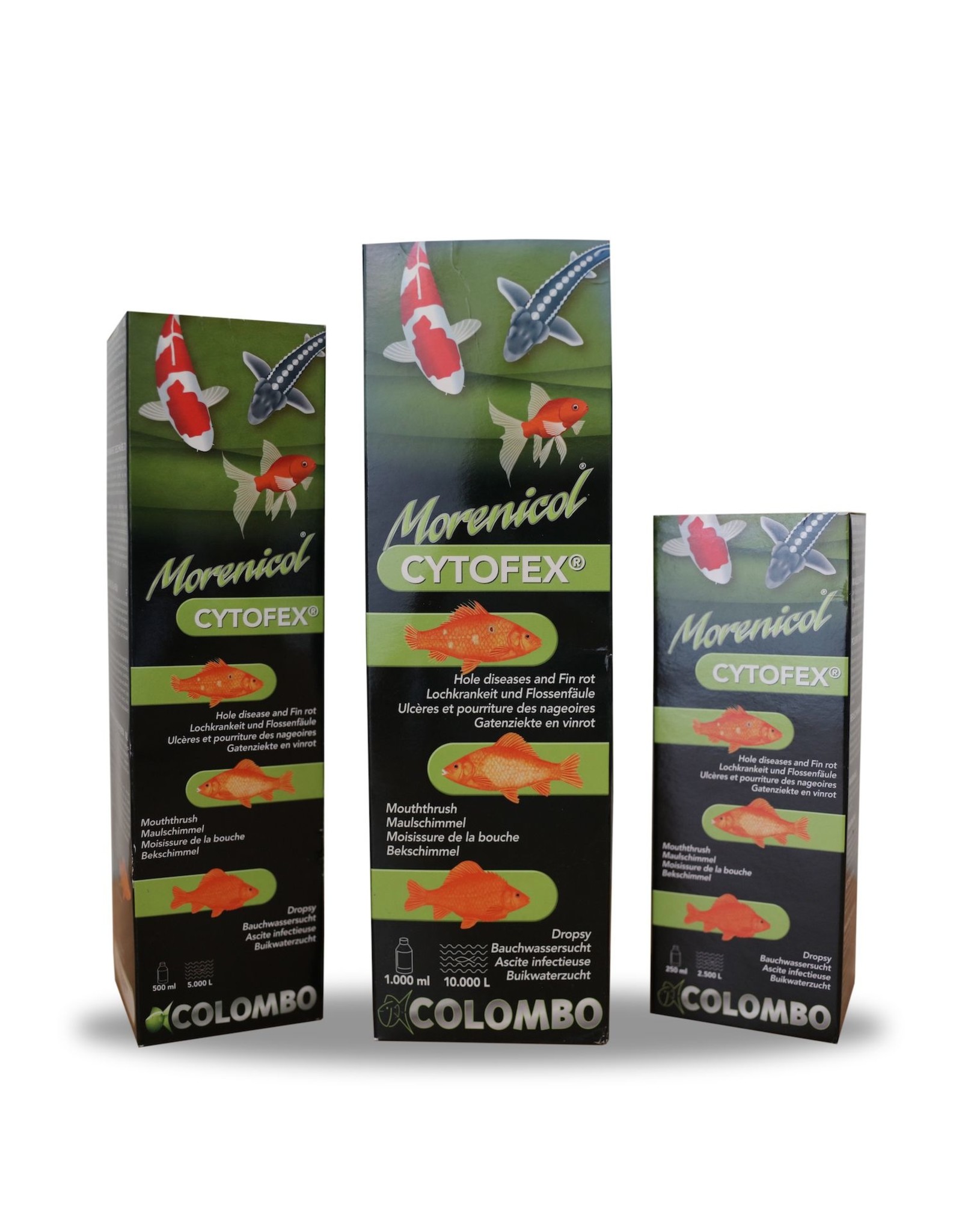Colombo Morenicol Cytofex is a unique herbal product effective against bacterial infections.
| Article number: | 5020325 |
| Delivery time: | 1-3 DAYS |
Colombo Morenicol Cytofex
Due to regulations, we unfortunately cannot send Colombo products to the United Kingdom.
Colombo Morenicol Cytofex is a unique herbal based product effective against bacterial infections such as skin ulcers, inflammation, fin rot and hole disease.
Cytofex is based on 100% natural raw materials that have a proven antibacterial effect, such as Tea Tree oil, extract from Icelandic moss and from the Pau d'Arco tree.
Application of this drug is at your own risk. Consult the package leaflet before adding to the pond.
Available in:
- 250 ml.
- 500 ml.
- 1 Ltr.
- 2.5 Ltr.
General Instruction / Information:
Content calculation:
Calculate the contents of the pond as best as possible: length x width x average depth in decimeters = content in liters.
Morenicol Cytofex is available in:
250 ml packaging for 2,500 ltr pond water, 500 ml for 5,000 ltr, 1,000 ml for 10,000 ltr and 2,500 ml for 25,000 ltr.
Water quality:
Good water quality is essential for the best possible effect of Morenicol Cytofex and rapid healing of sick fish. Therefore, always test the water quality before and after treatment and correct where necessary.
Dosage:
Cytofex should be used on 3 consecutive days.
Day 1: 1 ml per 30 liters of pond water;
Day 2: 1 ml per 30 liters of pond water;
Day 3: 1 ml per 30 liters of pond water.
Use:
Do not change water between applications. A measuring cup is included in the package. Shake before use. Measure the required amount in the measuring cup and pre-mix with water in a watering can or bucket. Then spread evenly over the pond. The active substances in Cytofex are natural substances and so the oxygen content in your pond can decrease due to the biodegradation of these substances. Therefore, ensure optimal aeration of your pond, so that your fish have sufficient oxygen at all times; fish species such as sturgeons are particularly sensitive to this.
Do not filter over coal or zeolite; Keep UV lamps and ozone devices switched off for up to 1 week after the last administration.
Warning:
As far as is known, this product is harmless to aquatic animals such as frogs, salamanders, lobsters and snails.
Only for use with ornamental fish in ponds. Store between 4 and 32 ° C in the packaging and out of reach of children. Do not breathe. Avoid contact with skin and eyes. If ingested, consult a physician immediately and show the packaging or label.
Combinations:
The effect of a combination with other agents is unknown. The use of more than 2 preparations in a combination is expressly at your own risk.
Effect on other animals:
Pets and birds drink from the pond with these resources in it. As a rule, if fish can swim in it, it can be said that it is harmless for animals that only drink from it. Still, it makes sense, for example, to give pets (dogs and cats) who are used to drinking from the pond, just give them a bowl of water during the treatment.
Degradation:
Administered agents will disappear in ponds by natural processes, such as oxidation and breakdown by bacteria.
What to do with auxiliary equipment:
Keep UV lamps, ozone generators, algae magnets and carbon filters turned off for up to 1 week after the last administration. Underwater filters or simple side filters that work without oxygenation: Thoroughly clean and replace filter contents beforehand or over cotton wool
filter. Leave the filter on and clean if necessary. To promote the biological balance, it is recommended that 1 week after the last administration, thoroughly clean the filter and add Colombo Fish Protect to the pond water. Still a day later, the biological filtration can be stimulated by adding Colombo Filterstart (live nitrifying
bacteria) to the water.
General information:
hole disease, skin ulcers, beak fungus and fin rot, are caused by bacteria, mainly by the species Cytophaga columnaris (formerly called Flexibacter). If the mucous membrane of the skin is damaged (for example, abrasion, fish lice or another disease, such as a white dot), the bacteria can
strike. From the damaged spot, they expand in a circular fashion, creating round holes or sores. The dead skin first becomes white, which makes it appear that the fish is full of white spots. This is very often confused with mold. If the white skin falls off, we get a red hole, the “skin ulcer”. When one sees white compact spots on the mouth, this is often the case
Beak fungus. The fins can be so badly damaged that they hang in fragments “Fin rot”. The fish become listless and if the gills or internal organs are also affected, a rapid death ensues.






